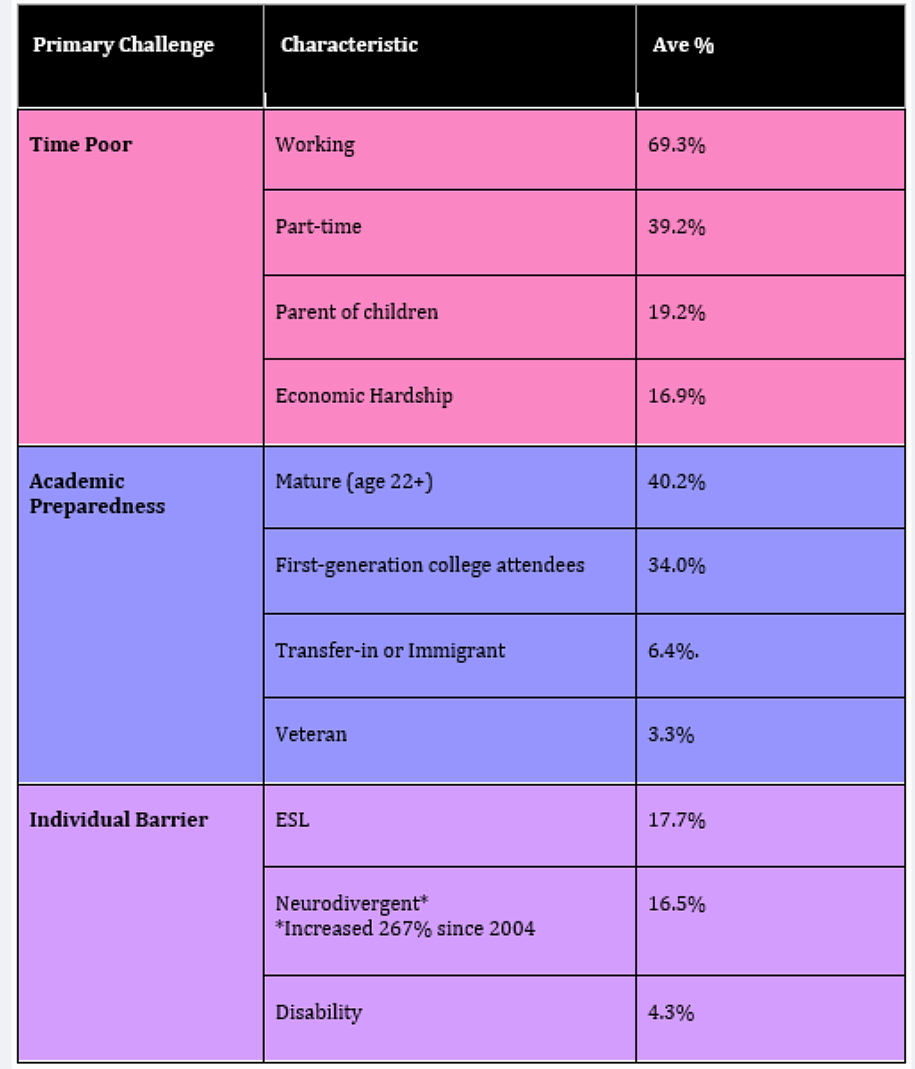
Higher education is navigating a significant demographic evolution. The once predominant “traditional” student is now part of a broader, more complex picture known as the “New Majority learner.” This diverse cohort is not an outlier but rather a core component of our academic communities. For institutions committed to meaningful reform and fostering student success, understanding and proactively supporting this group is a fundamental imperative. We are being called to truly equip, empower, and encourage all who are a part of it.
So, who makes up this demographic known as the “New Majority learner?” The following chart gives a visual picture of their multifaceted nature:

While these markers identify components of the “New Majority,” the critical insight lies in recognizing the common, often intersecting, challenges they face. It is through identifying shared hurdles that institutions can develop a strategic focus for fostering success across their diverse cohort.
Without tailored support, learners can experience a “disengagement cycle,” which affects their well-being, persistence, and ultimate success. As the National Student Clearinghouse Research Center indicates, part-time learners, for example, complete credentialing at a markedly lower rate—33.7 percent—compared to their full-time peers—67.2 percent. A genuinely learner-centric institutional approach must therefore address each student’s distinct challenges with precision.
Three fundamental challenges are particularly prevalent for the “New Majority.” Each of them is addressable with unique, targeted strategies.
Time Poverty
Juggling demanding jobs, family duties, and often lengthy commutes leaves these learners with fragmented and often scarce time for studying. This is known as time poverty. Not only does this create immense stress, but it also limits a student’s ability to engage deeply with coursework, participate in campus life, or access support services during conventional hours.
To directly combat time scarcity, asynchronous learning platforms can provide crucial flexibility, allowing access to materials and lectures on demand. Tools that enhance study efficiency—such as note-taking tools, artificial intelligence (AI)- powered quiz generators, and tools to assist with finding academic sources—help students maximize their precious study time.
In addition to this, targeted workshops and embedded curriculum focusing on strategic time management, effective prioritization, and techniques for deep, focused study sessions—even in short bursts—can equip students with practical coping mechanisms.
[RELATED: How I Introduced My Students to Personal Finance]
Academic Preparedness
Academic preparedness is not an issue of capability, but rather one of diverse educational backgrounds and life paths. First-generation students may lack inherited “college knowledge,” while veterans or mature learners may need to re-acclimate to academic rigor or refresh foundational study skills, leading to potential confidence gaps.
Adaptive learning technologies can provide personalized pathways to refresh foundational concepts tailored to individual needs. AI tutors can provide immediate, non-judgmental support for basic questions, while specialized software can scaffold academic note-taking, communication skills, critical reading, and research skills.
Comprehensive orientation programs, dedicated study skills courses that cover best practices for note-taking, critical thinking skills, and research methodologies, as well as robust peer mentoring networks, are vital for building both the skills and the confidence to navigate academic expectations.
Individual Learning Barriers
Students with disabilities, neurodivergent learners, or English as an Additional Language (EAL) students often encounter significant obstacles in accessing and processing information through standardized teaching methods and platforms. This can lead to frustration and a sense of exclusion.
Assistive technologies are indispensable. This includes text-to-speech and speech-to-text software, customizable display options, screen readers, high-quality captioning for all video and audio content, and translation tools. Crucially, all core learning platforms must be designed from the ground up with Universal Design for Learning (UDL) principles.
Specific training on leveraging available assistive technologies effectively, coupled with dedicated EAL support programs and personalized learning strategy coaching, empowers these students to engage on an equitable basis.
Cultivating an Empowering Institutional Ecosystem: Taking a United Approach to Learner-Centricity
Addressing these multifaceted challenges demands more than piecemeal interventions. For quick wins, institutions can get started easily by offering tools to individual students who could benefit from them on a departmental basis. To have a lasting effect across campus, however, institutions must cultivate a cohesive, cross-functional support system. This means Academic Advising, Disability Services, IT departments, Center for Teaching & Learning, and Student Success teams are operating in concert and sharing insights on how best to support students. An IT infrastructure that captures key student engagement data using multiple tools and presents this data to the relevant departments, for example, allows for timely and targeted interventions. This holistic approach embeds UDL principles across campus and benefits all learners.
When evaluating any technology, including AI, institutions must be discerning, ensuring that tools genuinely augment learning, rather than replace it. Clear institutional guidelines on the ethical use of AI, alongside robust data privacy and academic integrity protocols, are non-negotiable.
This learner-centric reform is fundamentally about empowering students to engage more deeply and effectively with their education. By understanding the “New Majority” and strategically investing in tailored technological tools and skills development, universities can significantly improve student outcomes—enhancing grades, confidence, retention, and overall well-being—thereby truly fulfilling their mission to ensure every student succeeds.
Image by 浩生 陈 on Adobe Stock; Asset ID#: 1553067573
